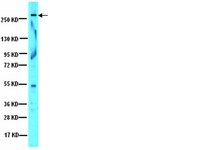Midkine promotes neuroblastoma through Notch2 signaling.
Kishida, S; Mu, P; Miyakawa, S; Fujiwara, M; Abe, T; Sakamoto, K; Onishi, A; Nakamura, Y; Kadomatsu, K
Cancer research
73
1318-27
2013
Abstract anzeigen
Midkine is a heparin-binding growth factor highly expressed in various cancers, including neuroblastoma, the most common extracranial pediatric solid tumor. Prognosis of patients with neuroblastoma in which MYCN is amplified remains particularly poor. In this study, we used a MYCN transgenic model for neuroblastoma in which midkine is highly expressed in precancerous lesions of sympathetic ganglia. Genetic ablation of midkine in this model delayed tumor formation and reduced tumor incidence. Furthermore, an RNA aptamer that specifically bound midkine suppressed the growth of neuroblastoma cells in vitro and in vivo in tumor xenografts. In precancerous lesions, midkine-deficient MYCN transgenic mice exhibited defects in activation of Notch2, a candidate midkine receptor, and expression of the Notch target gene HES1. Similarly, RNA aptamer-treated tumor xenografts also showed attenuation of Notch2-HES1 signaling. Our findings establish a critical role for the midkine-Notch2 signaling axis in neuroblastoma tumorigenesis, which implicates new strategies to treat neuroblastoma. | Immunohistochemistry | 23243020
 |
The Notch ligand Jagged2 promotes lung adenocarcinoma metastasis through a miR-200-dependent pathway in mice.
Yang, Y; Ahn, YH; Gibbons, DL; Zang, Y; Lin, W; Thilaganathan, N; Alvarez, CA; Moreira, DC; Creighton, CJ; Gregory, PA; Goodall, GJ; Kurie, JM
The Journal of clinical investigation
121
1373-85
2010
Abstract anzeigen
Epithelial tumor cells transit to a mesenchymal state in response to extracellular cues, in a process known as epithelial-to-mesenchymal transition (EMT). The precise nature of these cues has not been fully defined, an important issue given that EMT is an early event in tumor metastasis. Here, we have found that a population of metastasis-prone mouse lung adenocarcinoma cells expresses Notch and Notch ligands and that the Notch ligand Jagged2 promotes metastasis. Mechanistically, Jagged2 was found to promote metastasis by increasing the expression of GATA-binding (Gata) factors, which suppressed expression of the microRNA-200 (miR-200) family of microRNAs that target the transcriptional repressors that drive EMT and thereby induced EMT. Reciprocally, miR-200 inhibited expression of Gata3, which reversed EMT and abrogated metastasis, suggesting that Gata3 and miR-200 are mutually inhibitory and have opposing effects on EMT and metastasis. Consistent with this, high levels of Gata3 expression correlated with EMT in primary tumors from 2 cohorts of lung adenocarcinoma patients. These findings reveal what we believe to be a novel Jagged2/miR-200-dependent pathway that mediates lung adenocarcinoma EMT and metastasis in mice and may have implications for the treatment of human epithelial tumors. Volltextartikel | | 21403400
 |










